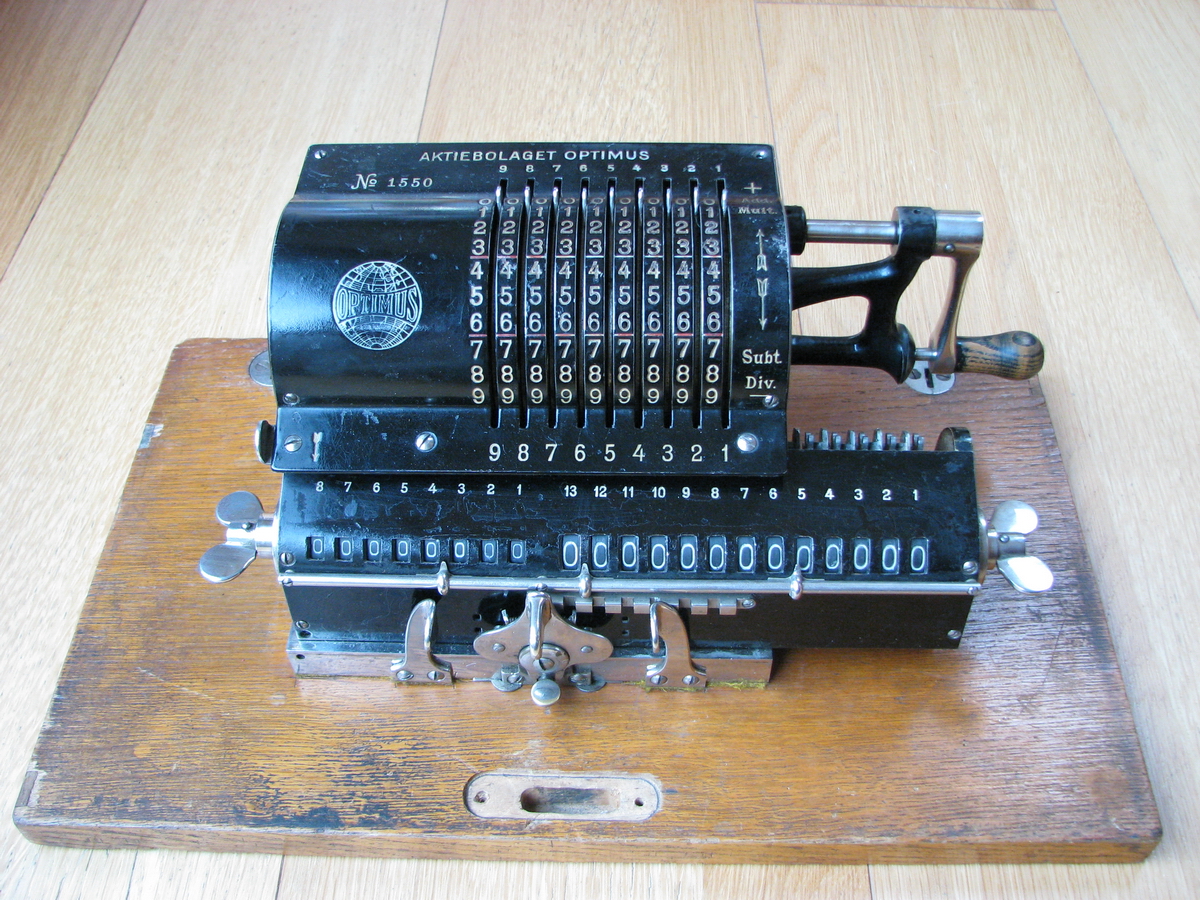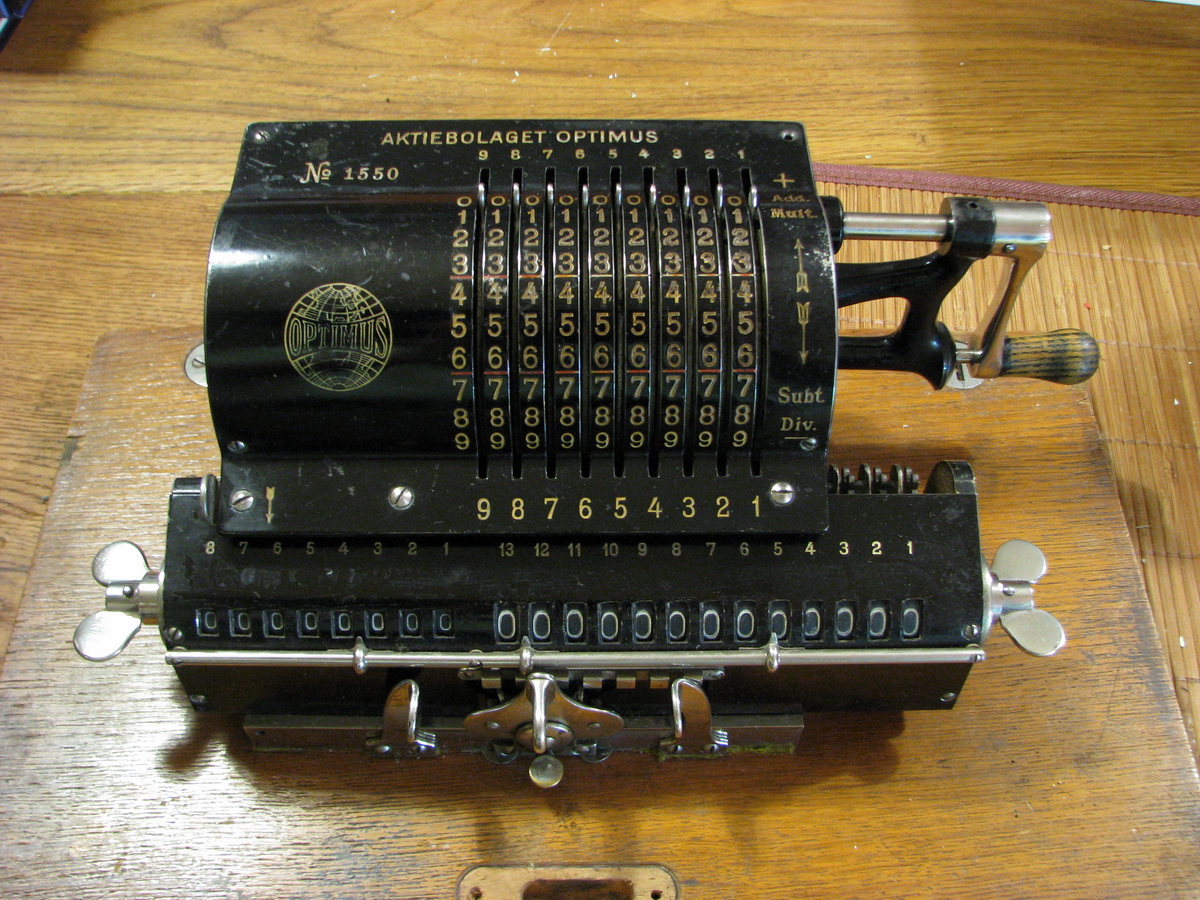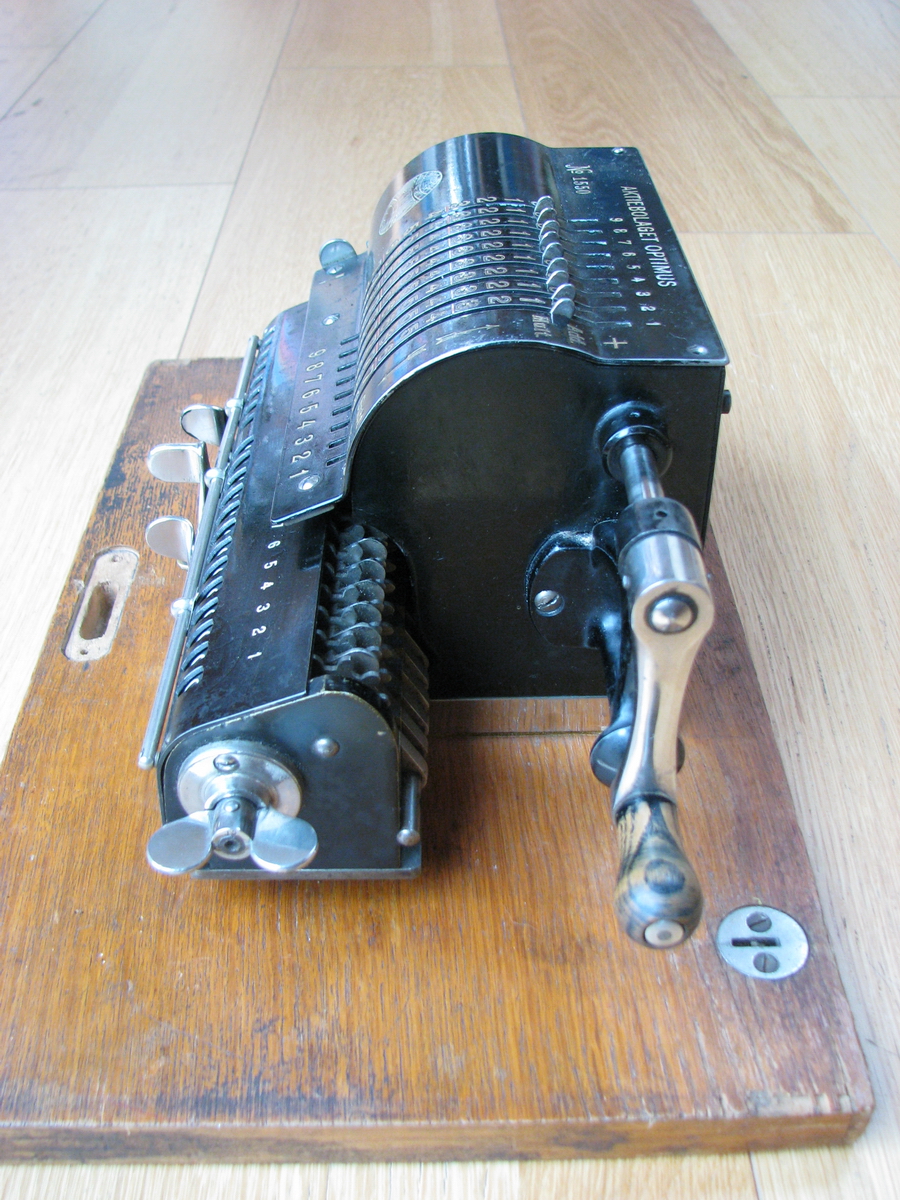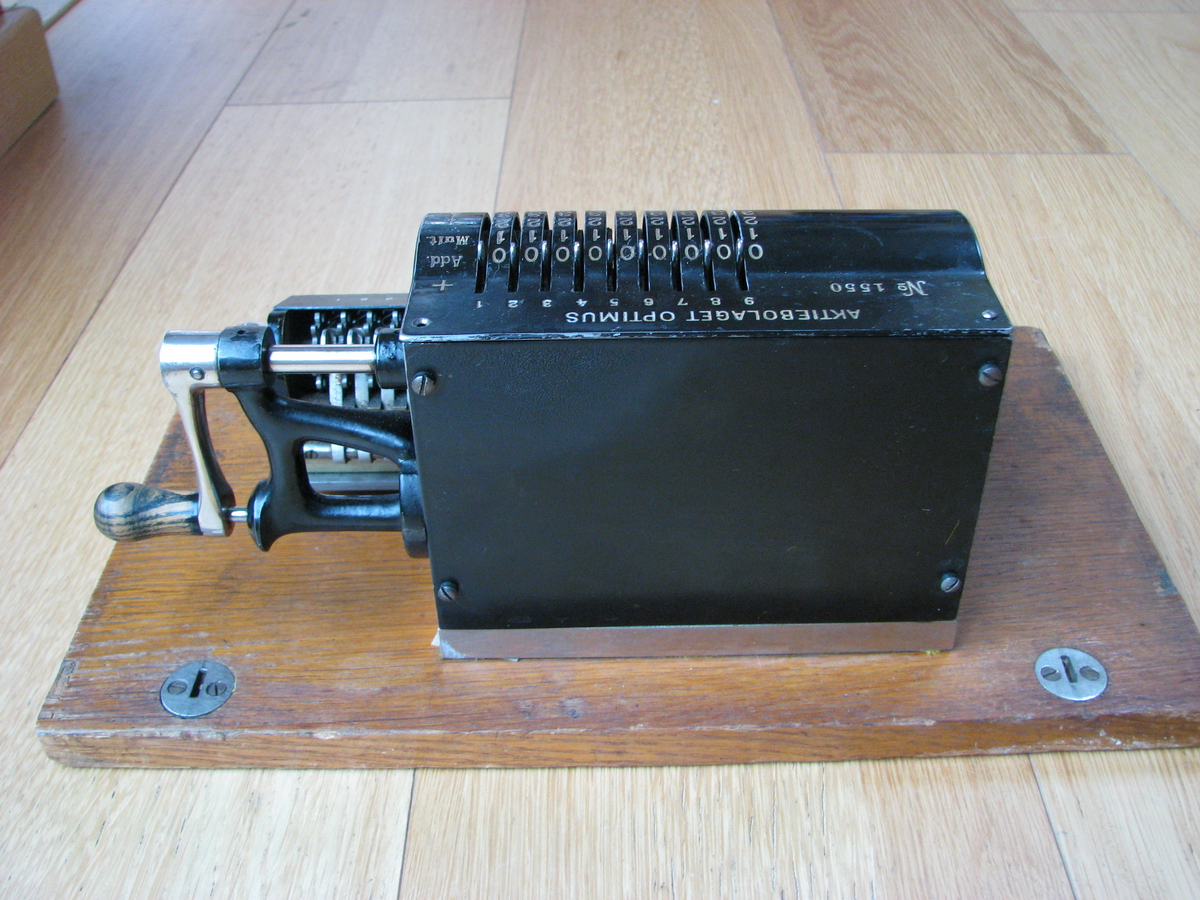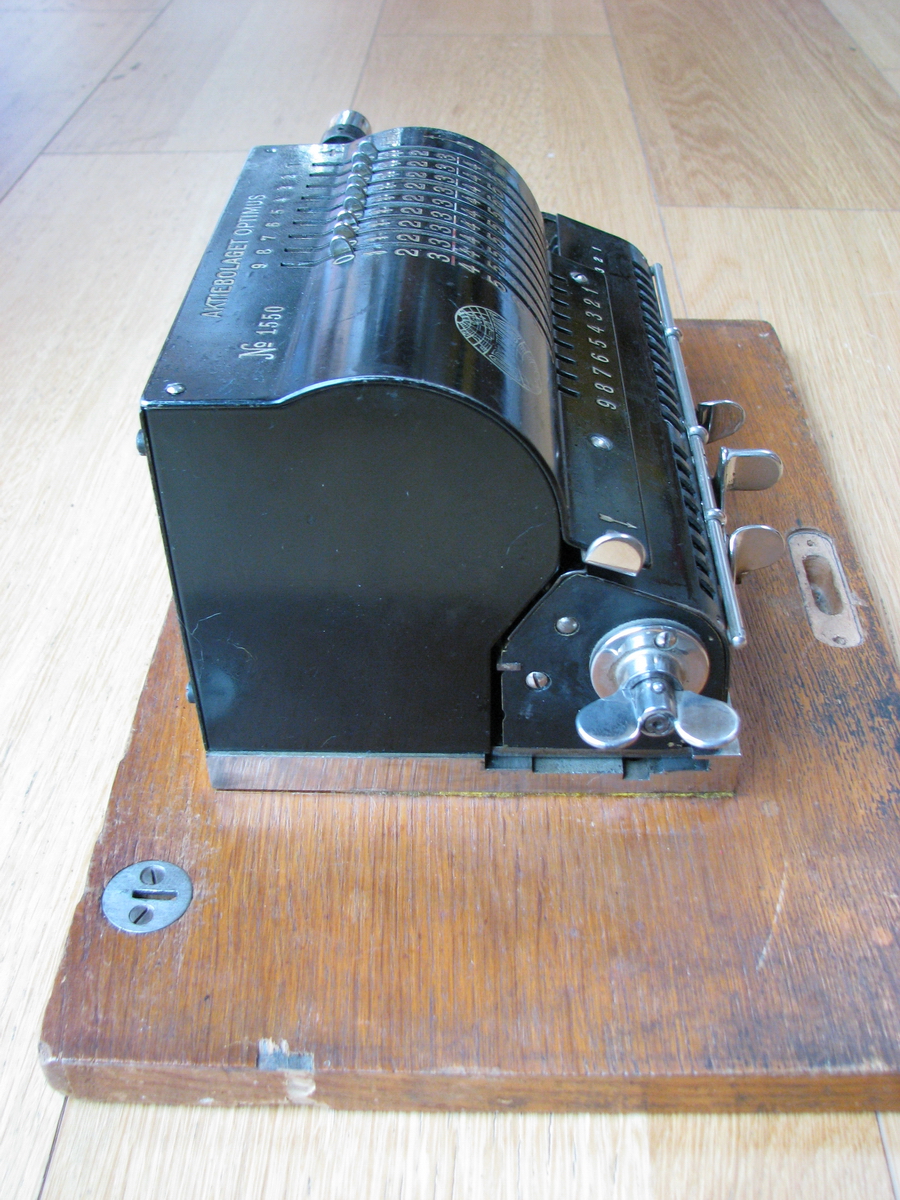Optimus
This is already quite a few years ago (summer 2016 I believe), but I had to be in Stockholm for some reason, I don't even remember exactly why - a workshop or a conference, probably. Beforehand, I had looked on the local second hand site and discovered that an "Optimus" calculator was for sale. Obviously, I couldn't let that slide, so I contacted the seller, we reached an agreement, and on a beautiful summer evening, I took the tram from my hotel at Bromma airport to a lakeside apartment. I was welcomed by a middle-aged peroxide blonde lady, who was very bright and cheerful. In fact, she had just returned from a holiday in Spain, which she told me she did every year, to go and bake on a beach and catch two non-stop weeks of sun (and indeed, that was what it looked like!). She insisted in making me coffee before showing me the calculator, which had been her dad's, and they had never been allowed to touch it when they were kids. She had no idea if it worked and how. But it did, I told her that I would be very happy buying it off her, paid her a downpayment for her next trip to Spain, and even though she gave the distinct impression and a few not-so-subtle hints that I needn't return to my hotel if I didn't want to, that would have been a little more than I bargained for - so I chose instead to take the calculator and run... its serial number is 1550.
After the usual airport shenanigans that ensue when trying to take a 10kg chunk of metal in your hand luggage, I arrived home with the Optimus calculator, and because it is so rare, instead of throwing it immediately on the website, I decided to write an article about it, together with Timo Leipälä, a very well-known Odhner historian with a penchant for archive work - and this was very welcome, because I read nor understand neither Swedish nor Russian! Together, we came up with a list of known machines (only 4 or 5) and we thought a bit about the history of how this machine could have come about - with the help of Staffan Rönn, who works for the Katadyn concern (which still produces camping stoves under the Optimus brand name), and is also a keen amateur company historian. How the calculator came about must have been intimately linked with the end of the Great War, the Russian revolution, the nationalisation and impending move of the Odhner factory to Moscow, perhaps the sale of old parts by the Bolsheviks or laid-off workers, either for scrap or presented as an opportunity to get a little creative - and at the same time the Optimus works, which specialized in lamps, petroleum stoves and all kinds of pressed metal goods (like locks), went through a bit of a crisis and a change of ownership, which somehow precipitated the creation of this machine.
These are some of the things Optimus normally made:
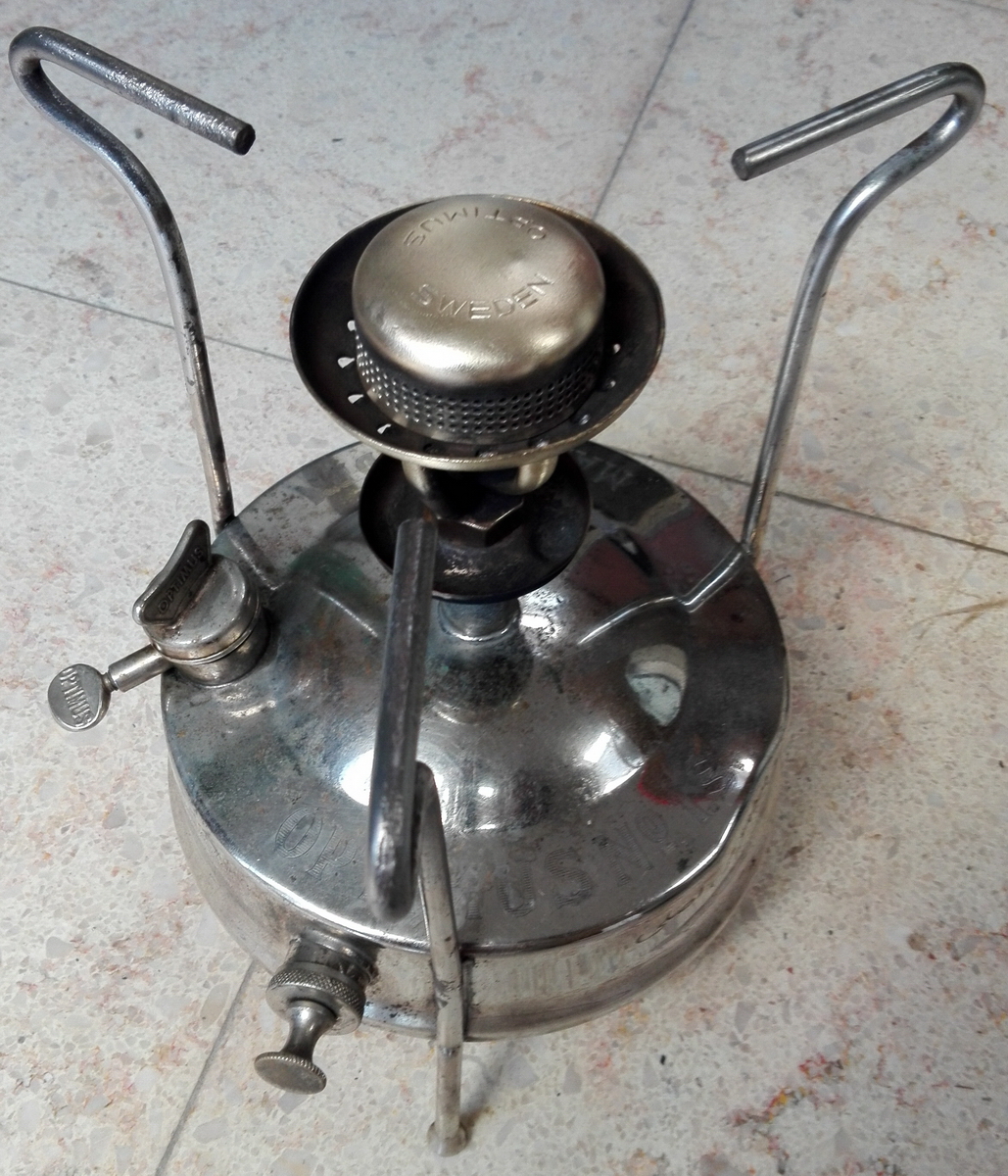
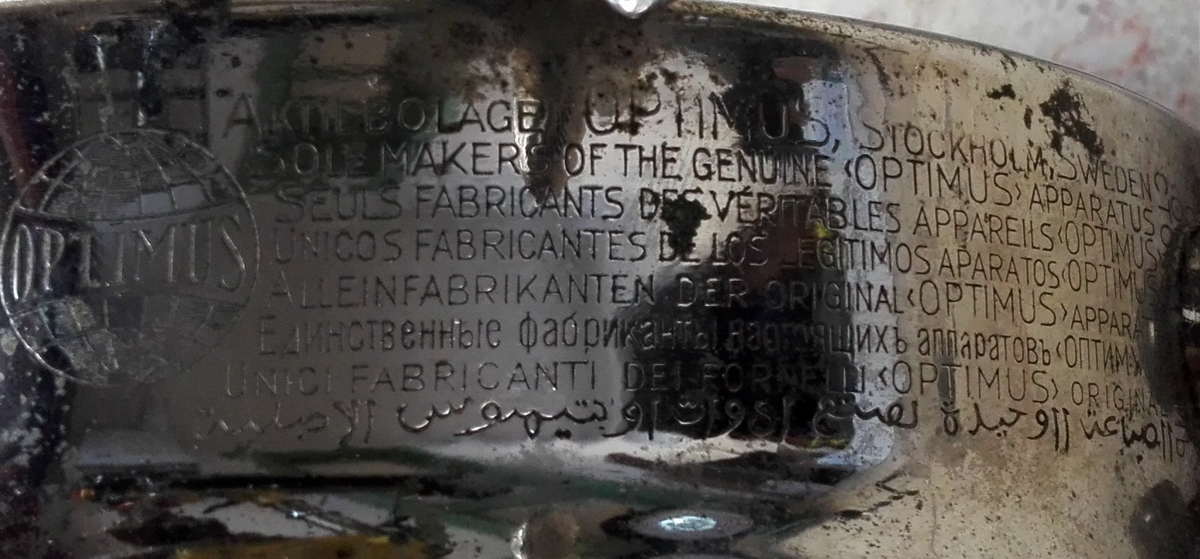
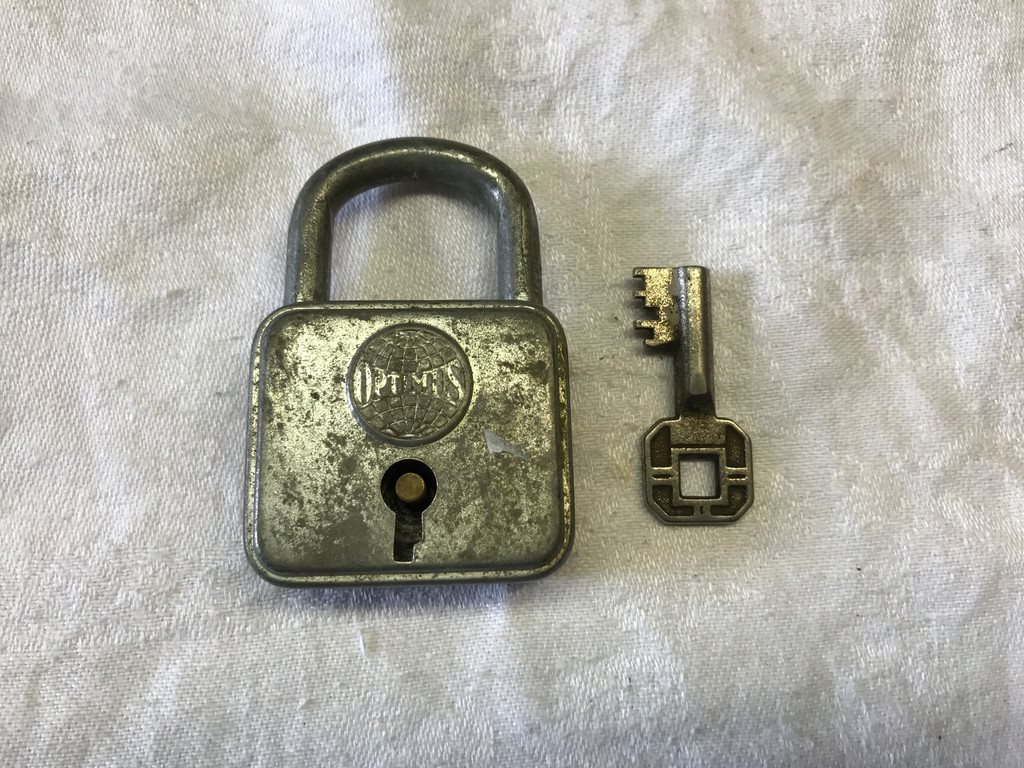
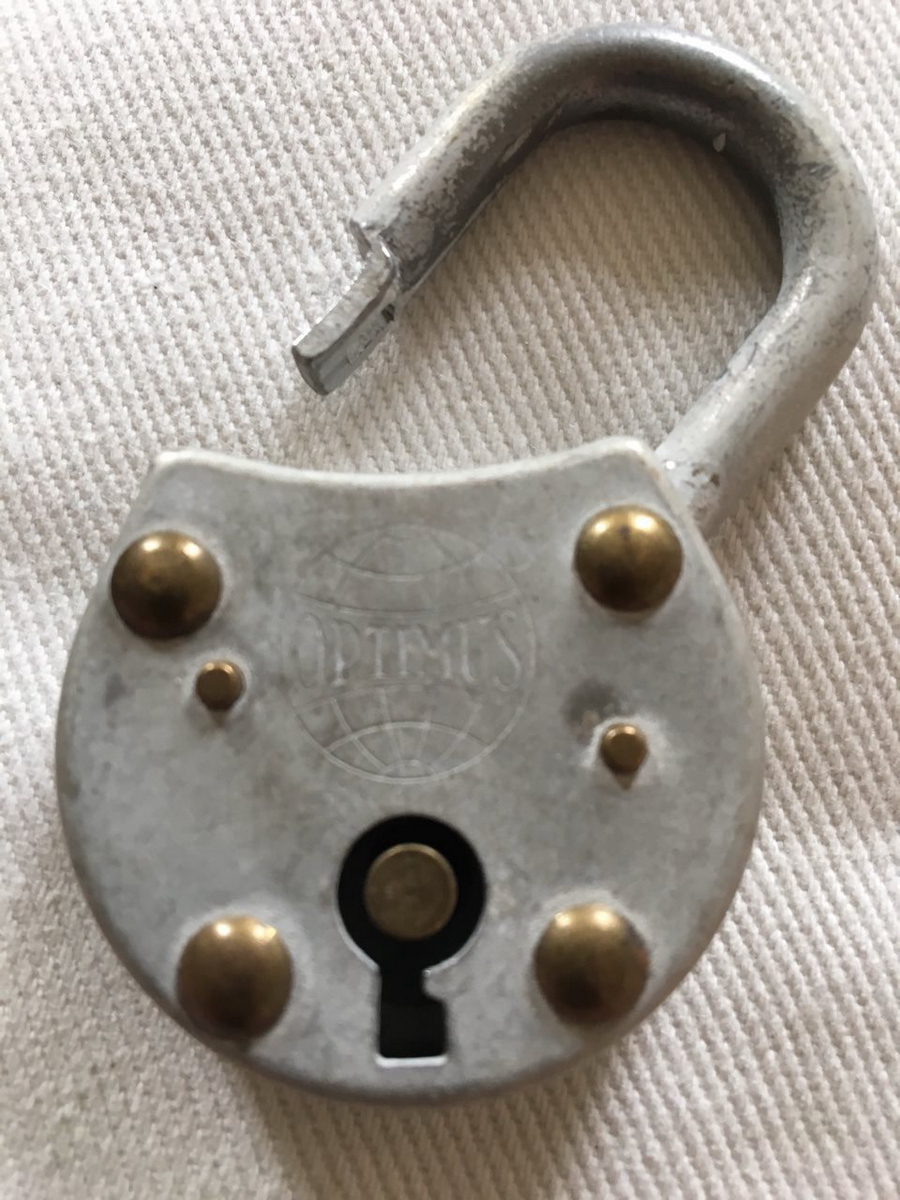
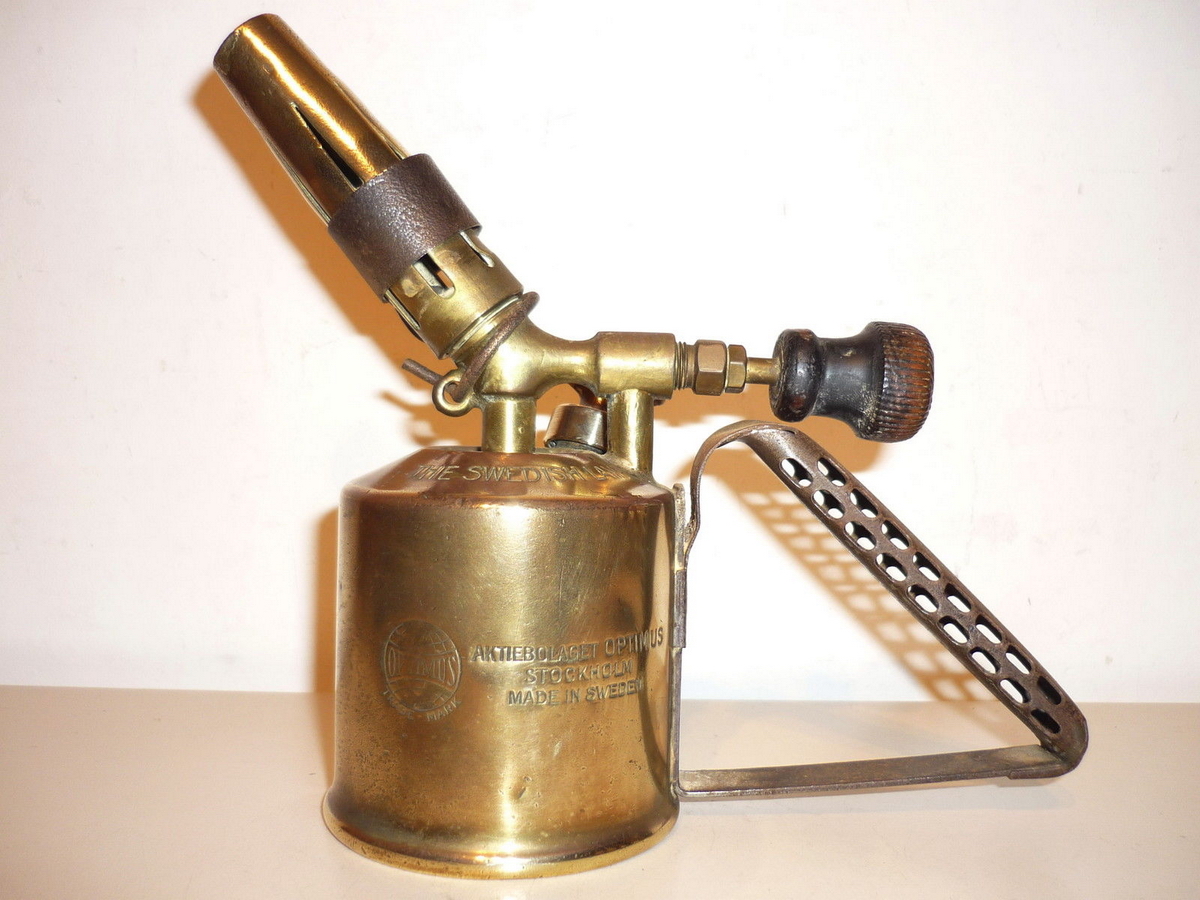
The complete article on this calculator can be found in the journal Historische Bürowelt, n° 119, of April 2020, on pages 26-30. All the back issues of HBW are avaialble to members of the IFHB, so if old calculators and typewriters interest you, I would definitely recommend to become a member!
The 1919 Optimus calculator is actually ... a 1912 Odhner. A few skillful adaptations have been made by someone who clearly knew what he was doing, but there is no way that a metalworks which specialized in stamping, cutting and bending could suddenly have mustered the lathes, mills and drilling machines necessary to make their own precision calculator parts - most of these would instead have come straight from Russia, either as old stock or surplus parts, as the Odhner calculators by 1919 had become a lot more sophisticated than the simple Odhner A and Ag models that this machine is largely identical to.
In Upplands Väsby, the Optimus factory then had some adaptations made to prepare this machine for the roaring 20s - but despite looking through all the relevant patents that we could find, the identity of the designer who developed these changes remains a mystery for now.
These are the differences we can observe between a 1912 Odhner basic model and the Optimus machine:
All the dimensions, screw locations, ... on the machine are clearly Odhner, the font on the numeral rolls is Odhner, and in fact, the top plate of Odhner N° 13097 can be fitted on Optimus machine N° 1550 without any issues. This is not even a given between Original Odhner machines of different vintage!
An Odhner carriage would also fit if not for the adaptations made to the base for the tabulator mechanism. The whole machine breathes approximately 1912 Odhner model A, with adaptations to bring it up to modern standard, and these adaptations clearly aren’t the same solutions Original Odhner implemented when moving the factory to Sweden and starting up production there with a completely new design. The relocation of the Odhner factory to Göteborg resulted in a new machine (the “Arithmos” line) in 1919-1920 that sprouted from the same minds as the earlier Odhner machines, but is completely different in size and execution of the key ideas. There is no way any of the earlier St. Petersburg parts will carry over into one of the Göteborg Odhner Arithmos machines, whereas with Optimus, all the parts appear to be identical to the earlier Odhners.
To give you an impression of how similar the machines are, here are some shots of a gaggle of calculators ...
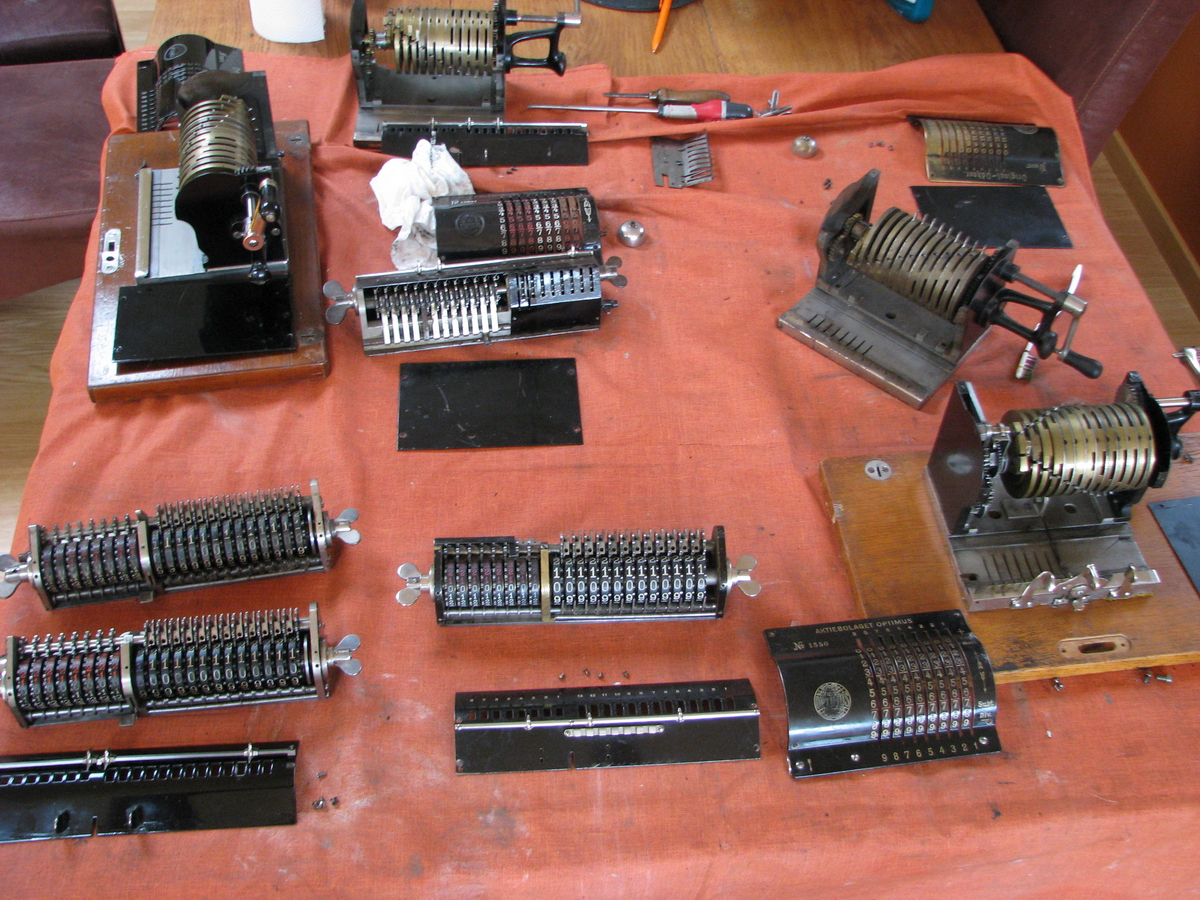
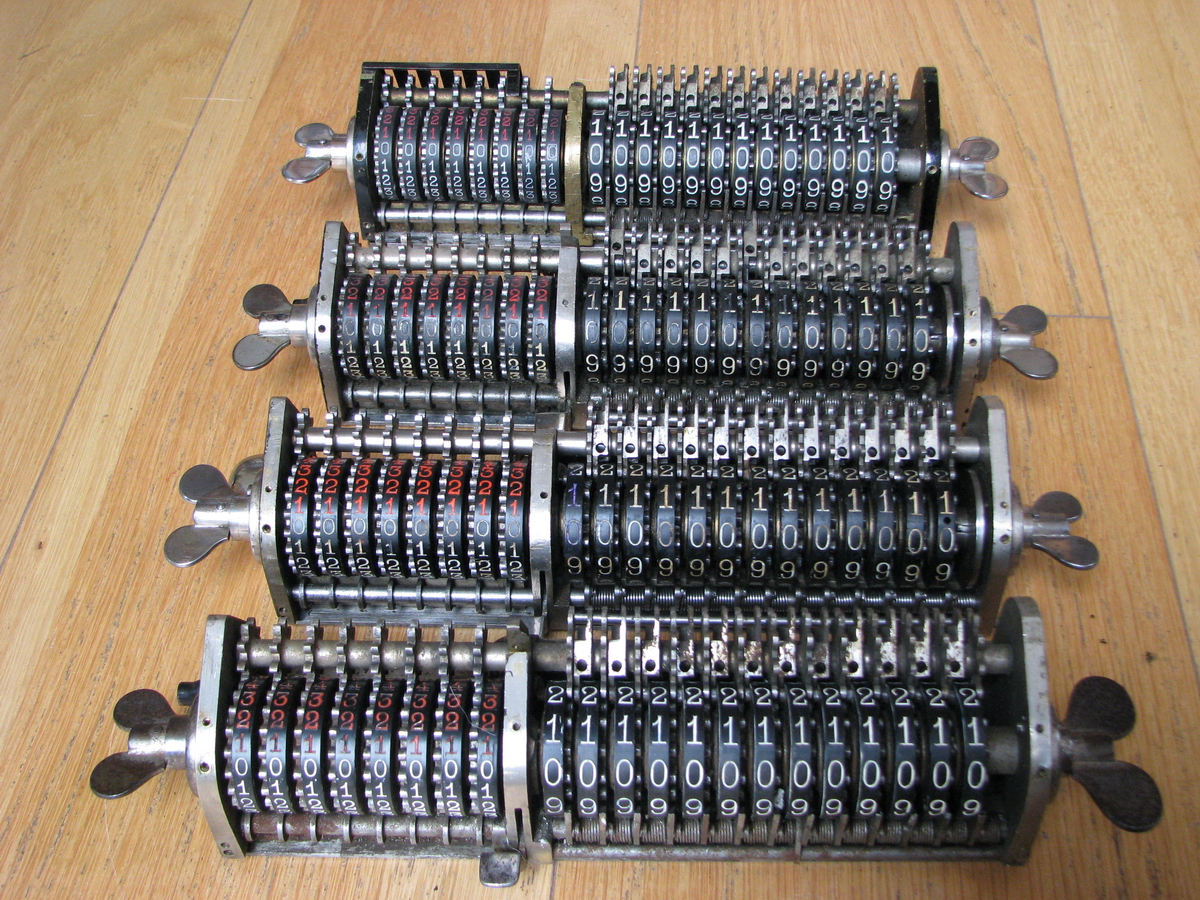
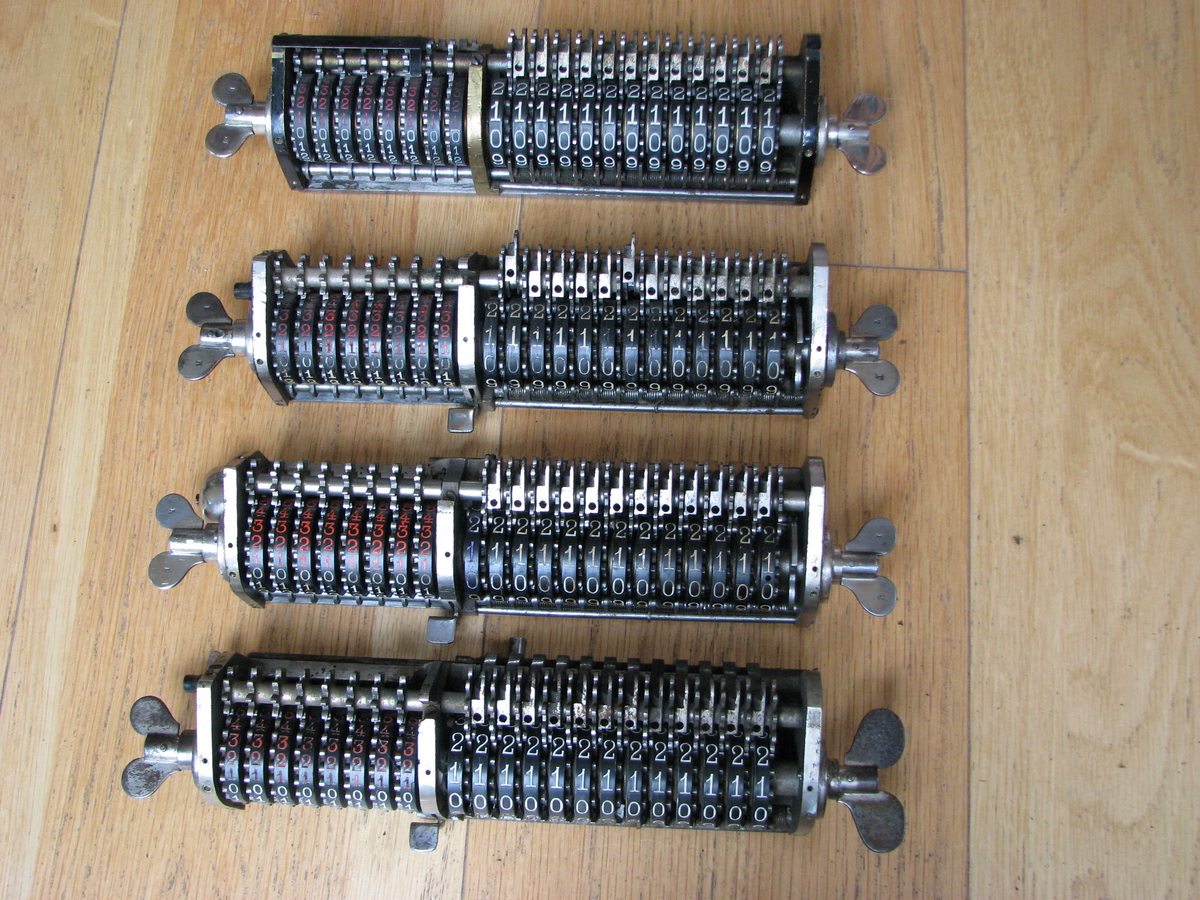

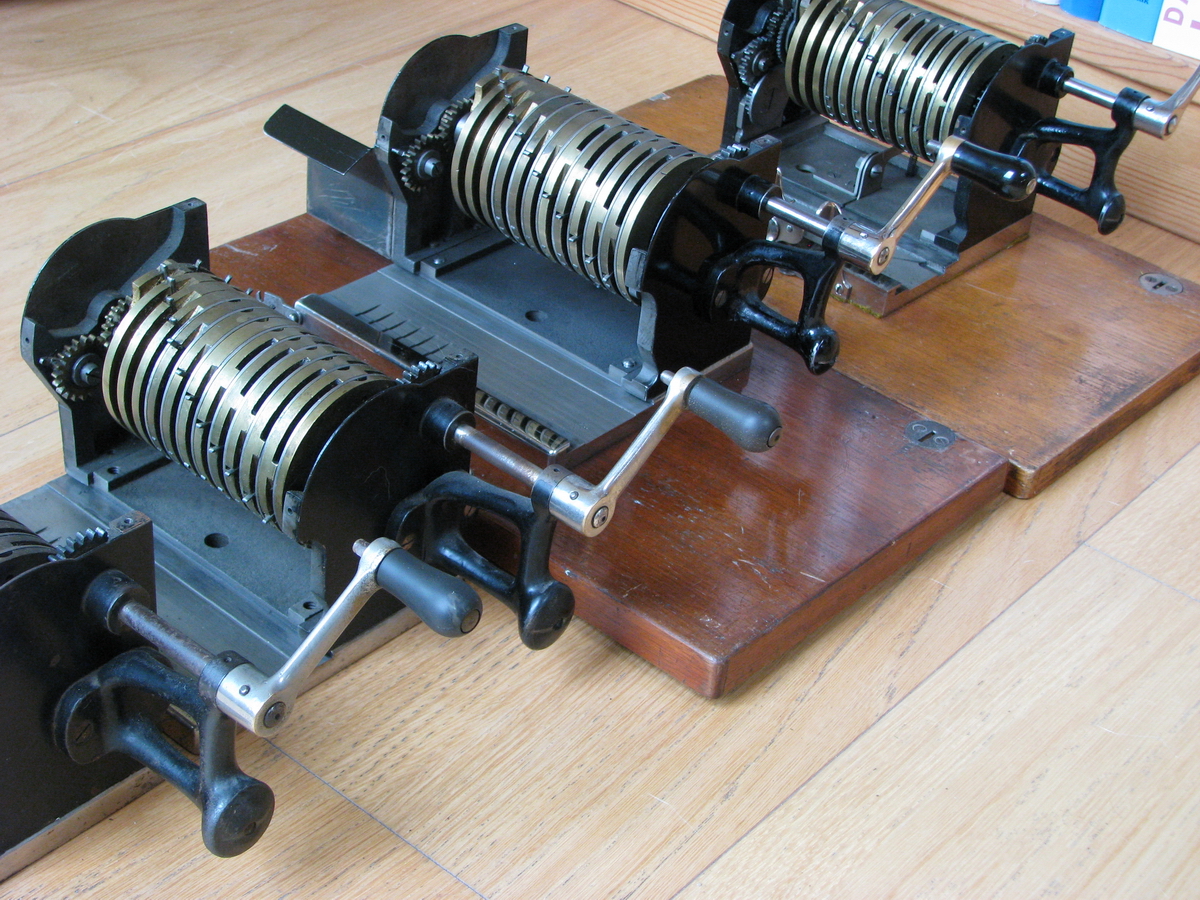
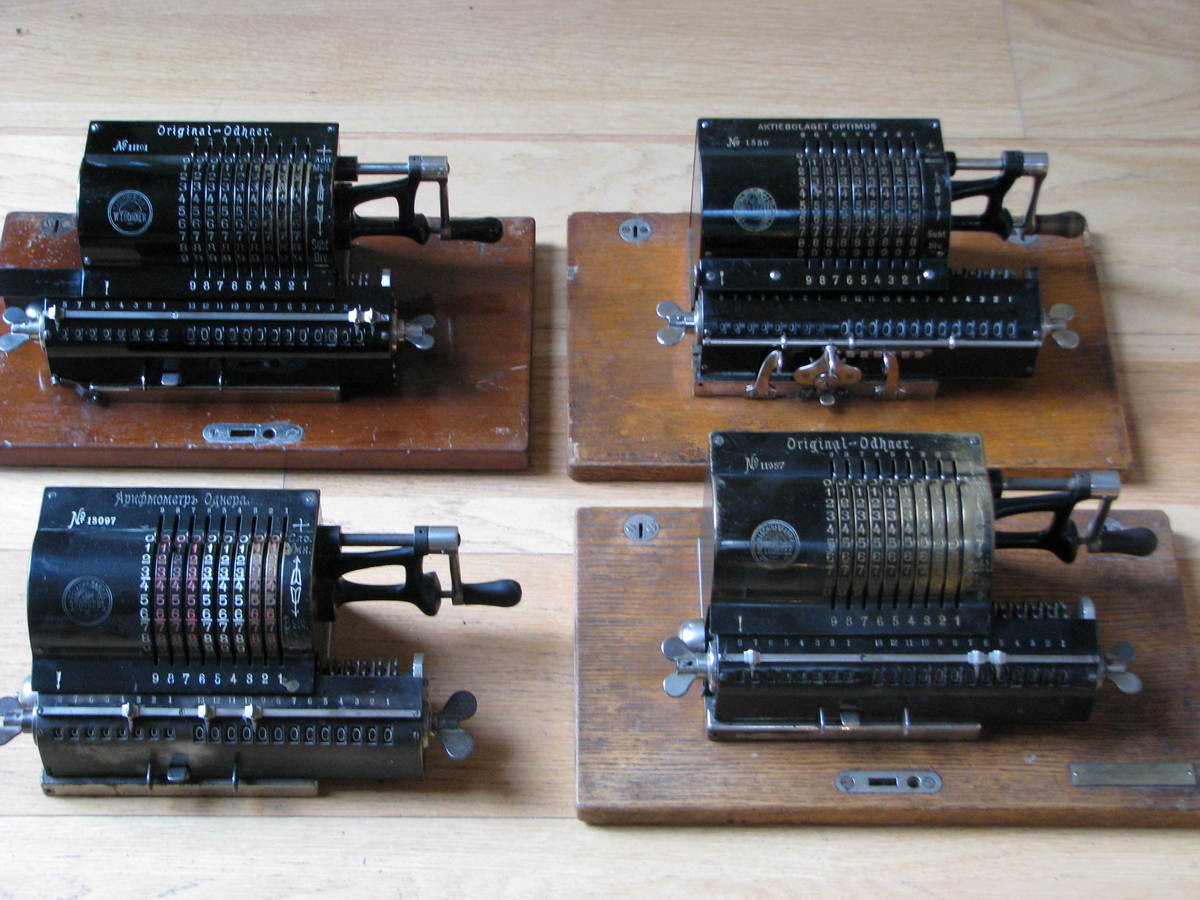
Some detail pictures of the adaptations: The bell now lives in the back of the carriage. This is an adaptation that is very easy to make and gives the machine a cleaner look.
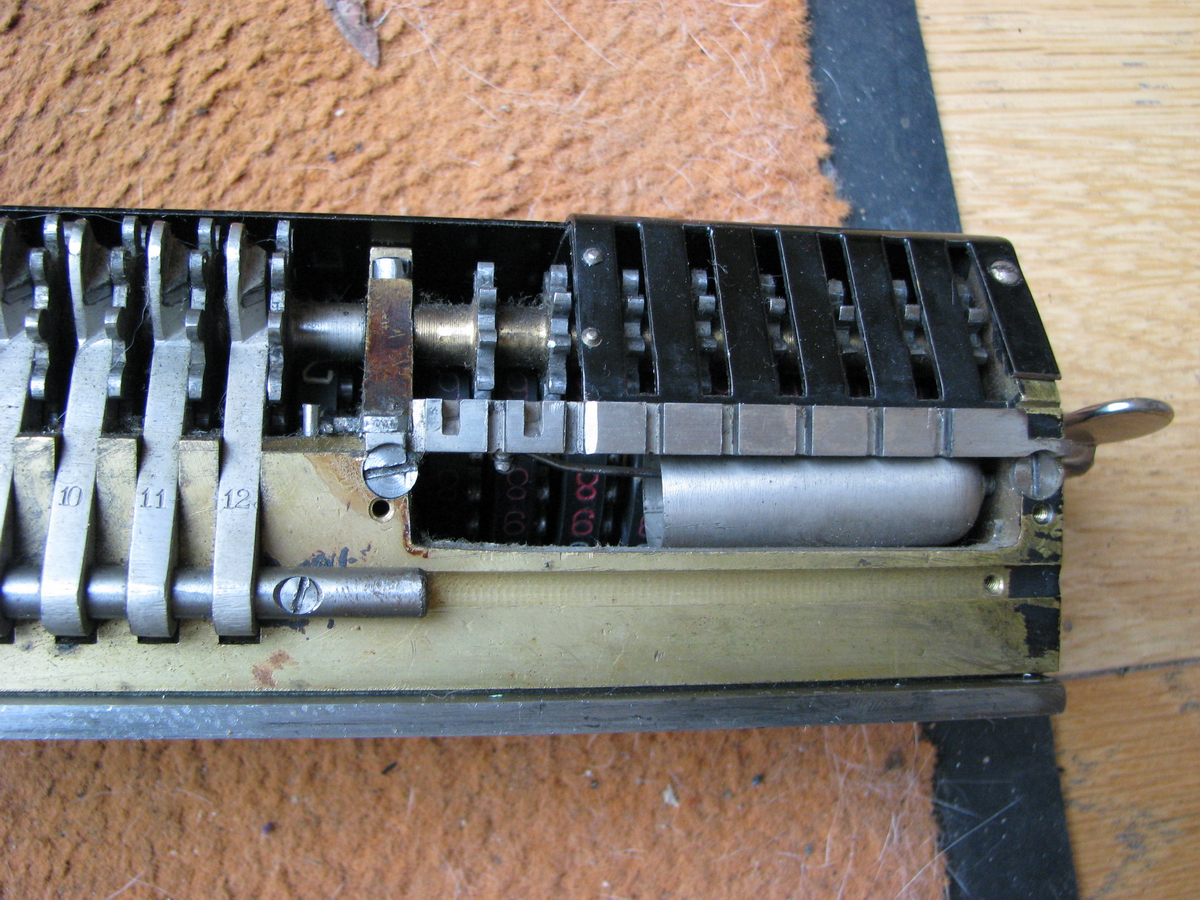
Direction change/safety mechanisms: The mechanism replaces the locknut for the pinwheel cylinder on the Odhner machines, and is linked to the setting register clearing, as well as to the pin on the main crank handle.
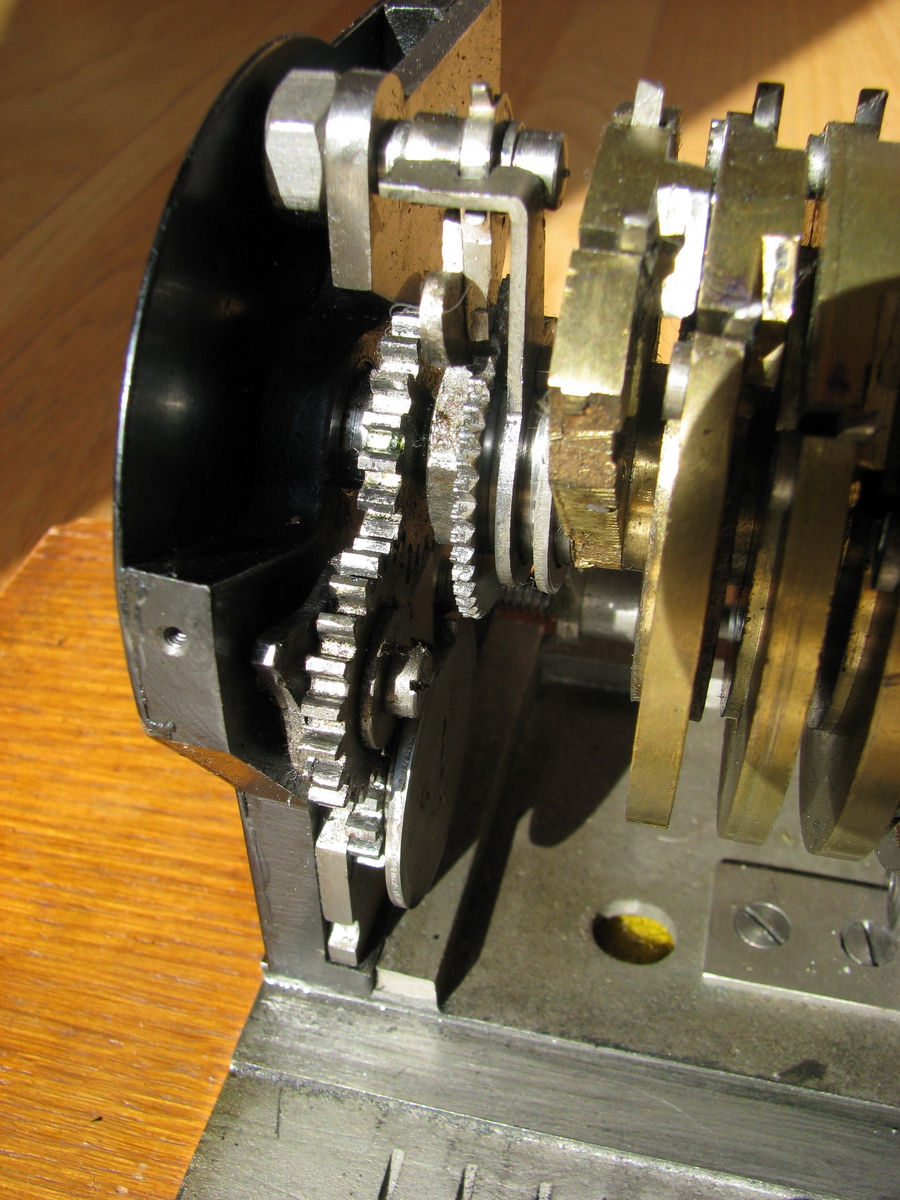
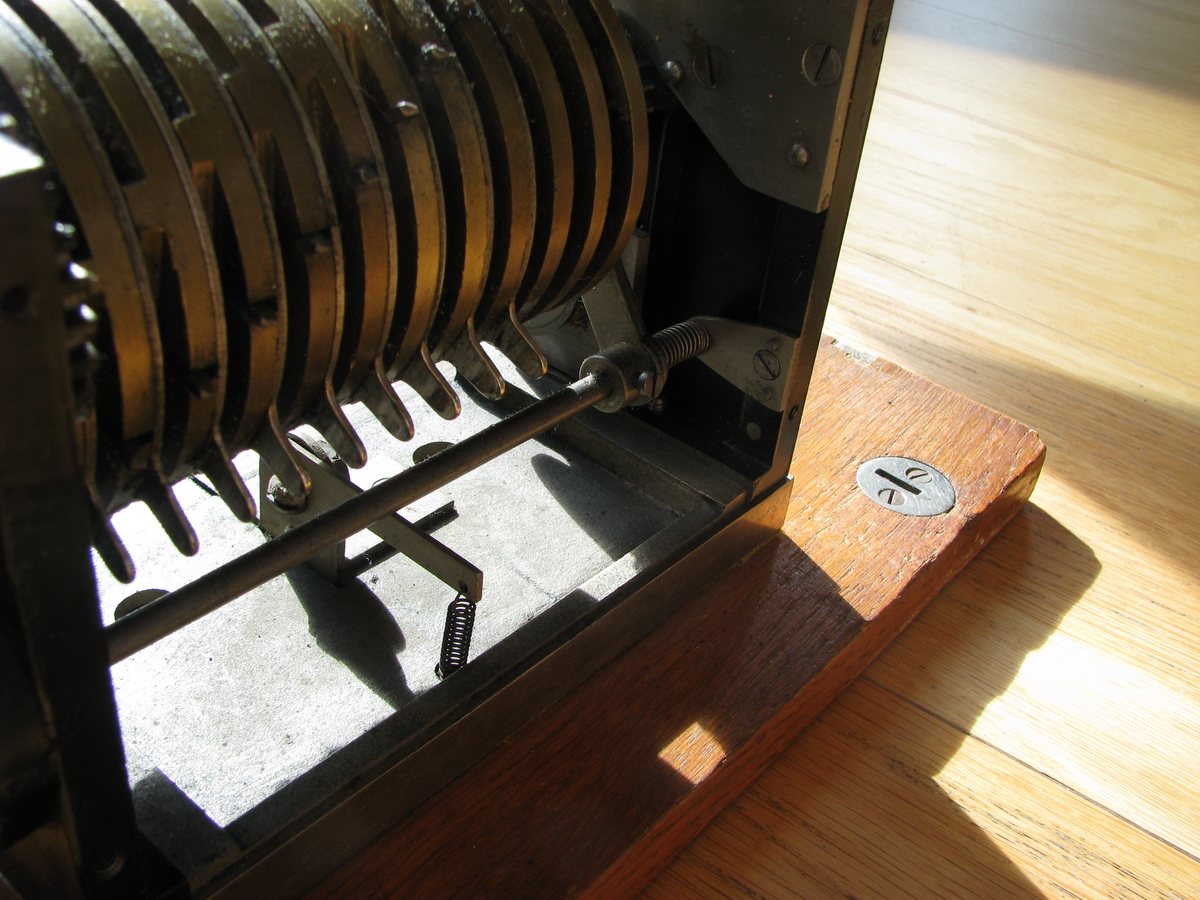
Lever attached to the clearing bar for operating both the direction safety and the blocking of pinwheels
The mechanism incorporates the classical fine-toothed gear with a gap, that entrains a pendulum at the start of the rotation of the pinwheel cylinder. This in turn is coupled to a tooth that will slide over the gear teeth in the direction the pendulum entrains it, but will lock the gear and the rotation of the pinwheel cylinder if the direction of the turn is reversed, so that a turn that has been commenced must also be completed. This mechanism communicates with the clearing bar for the setting register, which is mounted below the front of the top plate. The pendulum and tooth engage with the gear only if they can slide to the right on the pin on which they pivot. This sliding action is provided through a series of levers, by pulling out the main crank handle to the right.
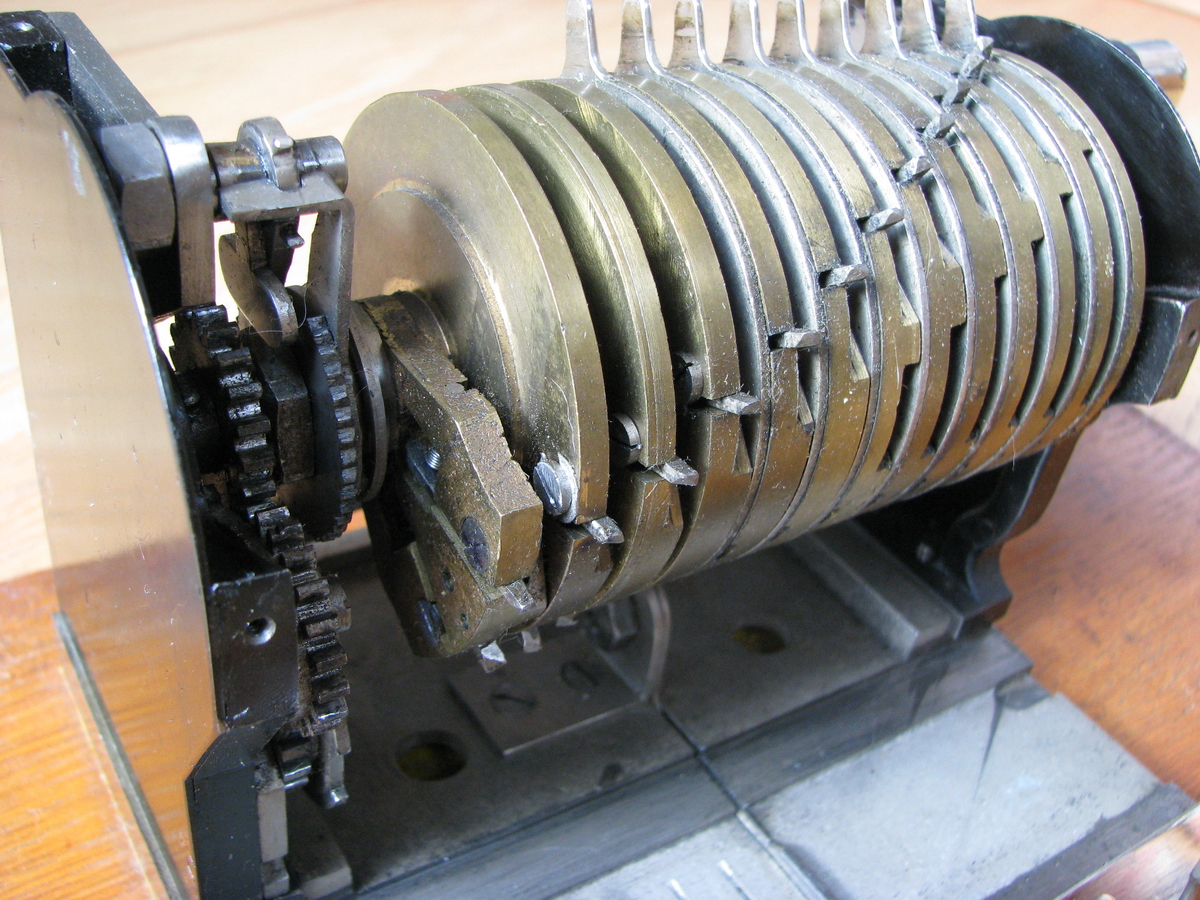
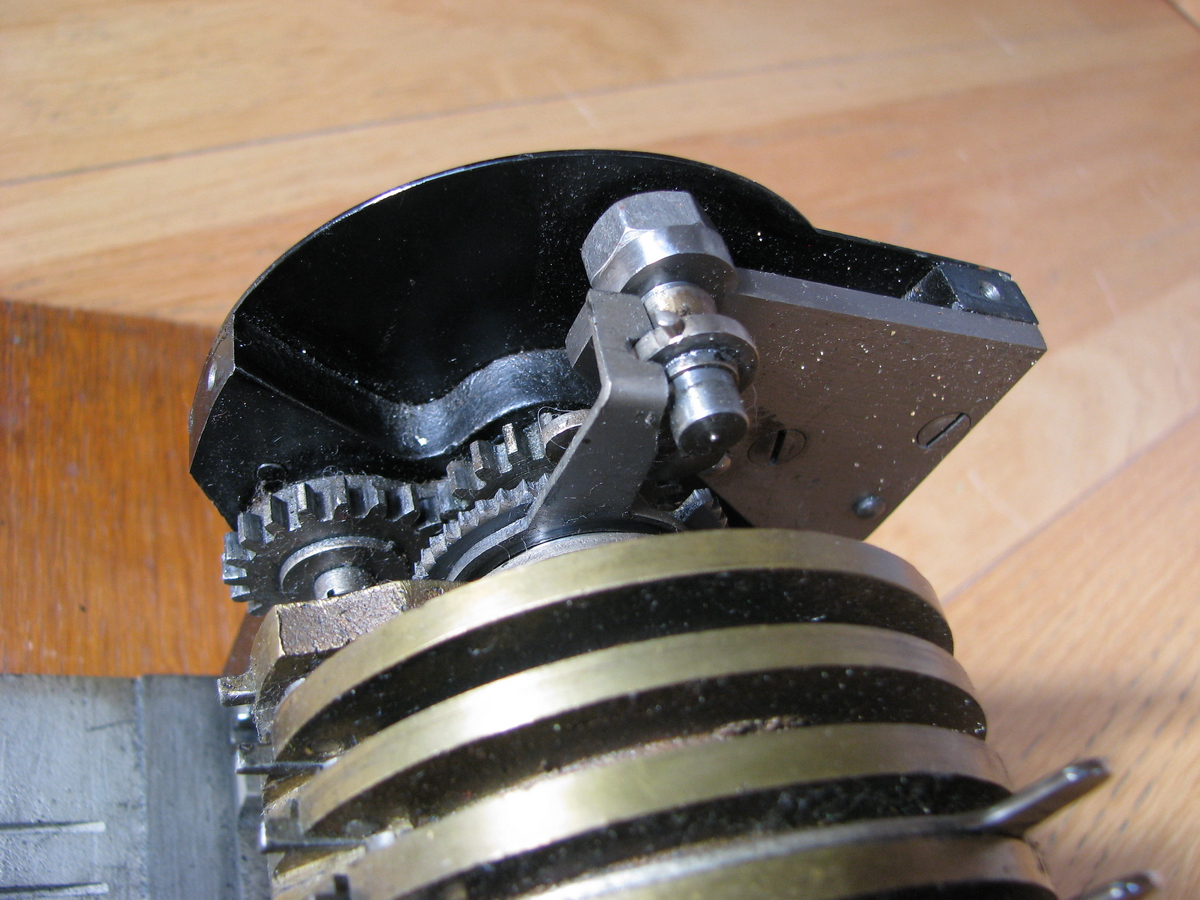
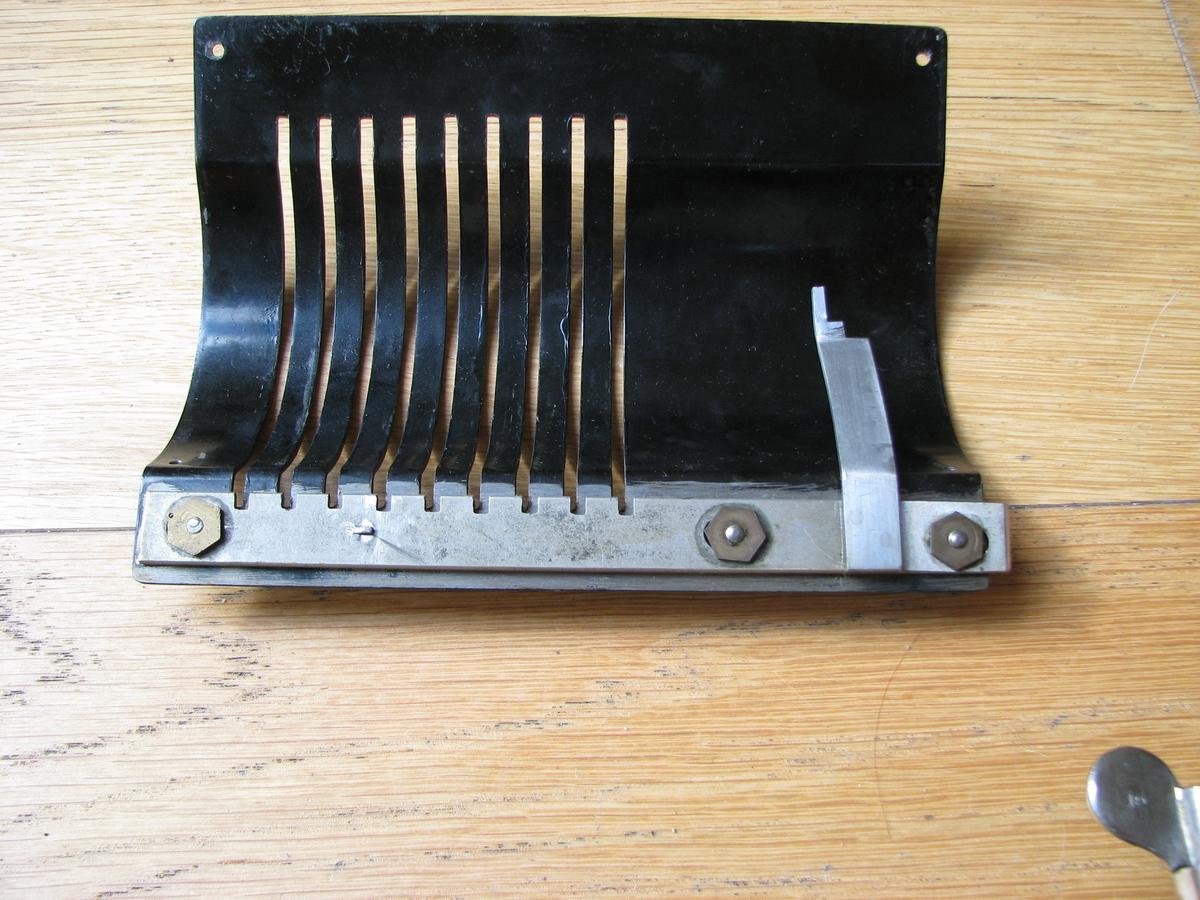
If the clearing bar on the top plate is simultaneously pulled to the left though, this movement to the right is prevented, and the direction safety thus doesn’t operate during clearing.
Another sophisticated interlock which is present on this machine is the locking of input pins. As soon as the mechanical ballet described above takes place – pendulum sliding to the right because the main crank handle is pulled to the right – it also shifts an interlock internal to the pinwheel cylinder (probably a toothed bar as in the Brunsviga machines), which then locks the input pins in position, preventing errors by changing the position of an input pin for whatever reason during rotation. Because these interlocks are both connected to the same action of the crank pin being pulled out, they can also be simultaneously defeated by pulling the clearing bar to the left, which is also necessary for the clearing of the setting register.
Finally, there is one more “classic” interlock, consisting of a slotted disc that rotates along with the pinwheel cylinder (through a gear train) interfering with a slotted bar on the carriage. This prevents a crank turn being started if the carriage is not in one of its resting positions, as well as preventing that the carriage is moved when the main crank is not in its resting position.
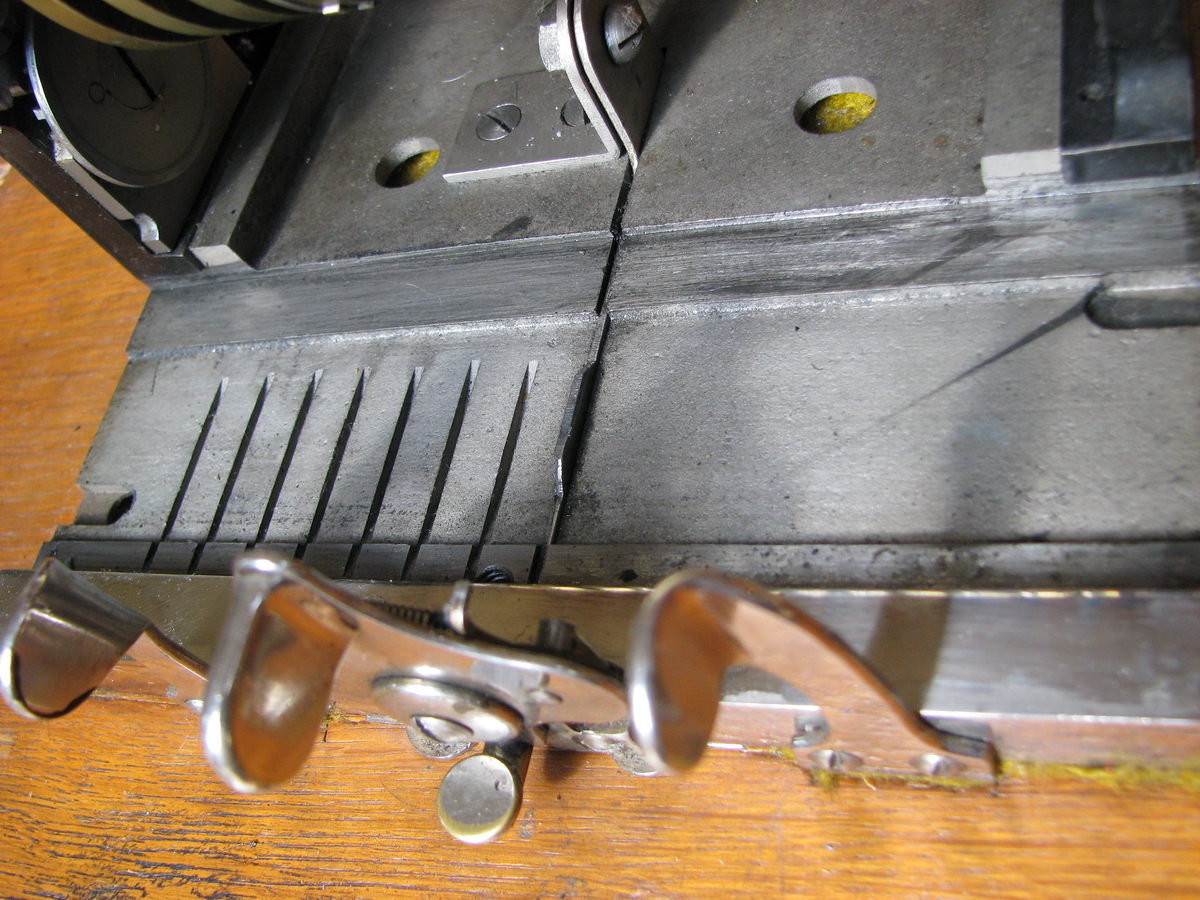
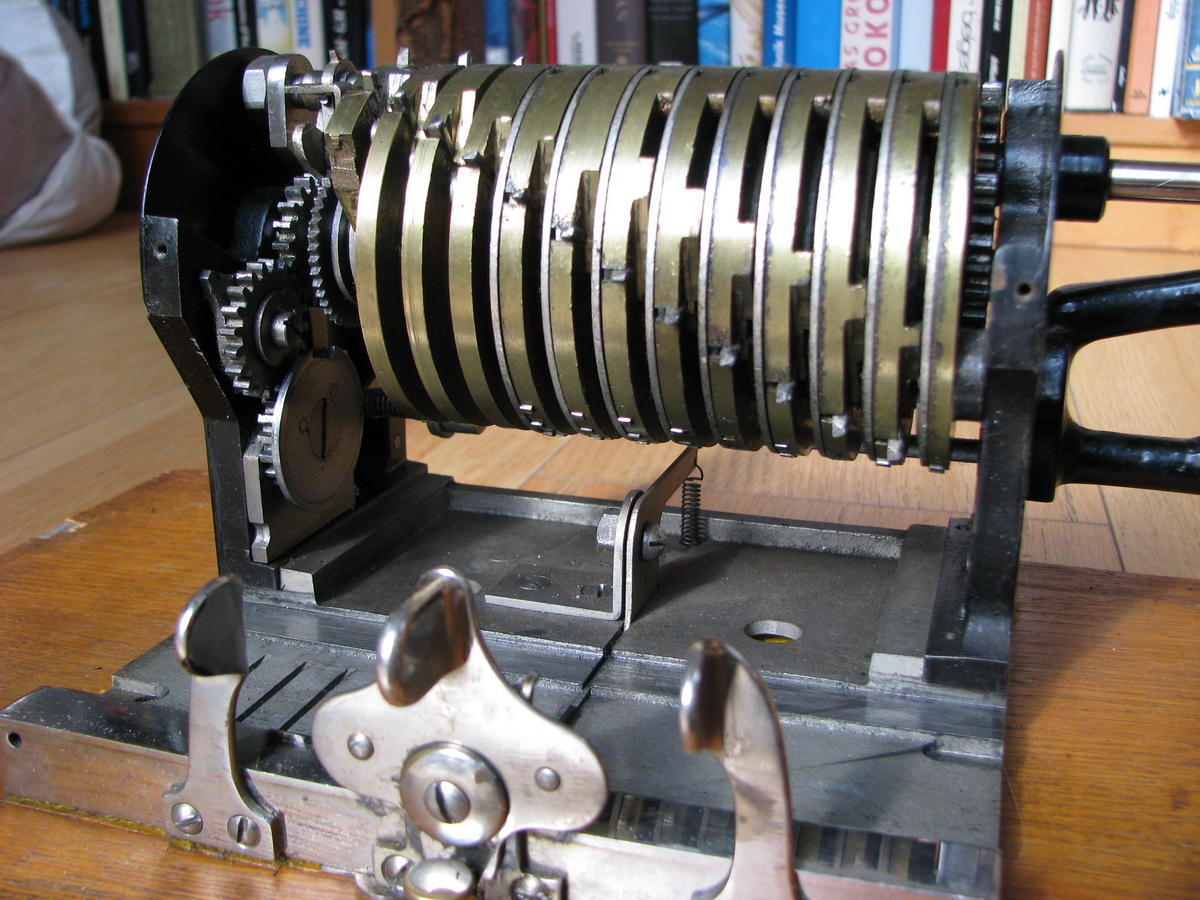
All of these interlocks have been attached to the machine by means of auxiliary machined steel frames that are bolted to the cast iron left hand bearing plate of the machine. Conspicuously absent is an interlock that prevents operation of the machine during a turn of one of the carriage wingnuts. It was probably impossible for space reasons to build this within the confines of the “old” carriages. In comparison, the first new Göteborg Odhner Arithmos type 5 machines have a (quite different) tabulator, but have no locking of the input pins, nor a direction safety. What they do have is a carriage position interlock (which is very similar to the one employed in the Optimus), as well as an interlock that prevents operation of the machine while clearing a carriage register, and the latter is missing in our Optimus. The way this works in the Odhner Arithmos is that the toothed bar for the carriage position interlock is moved backwards into a steel wheel with a single cutout when one of the carriage wingnuts is turned, thus changing all the “free” positions where there is a cutout in the bar to “locked” positions because the bar is pushed deeper into the cutout of the wheel. The Optimus does not have this, the toothed bar is fixed.
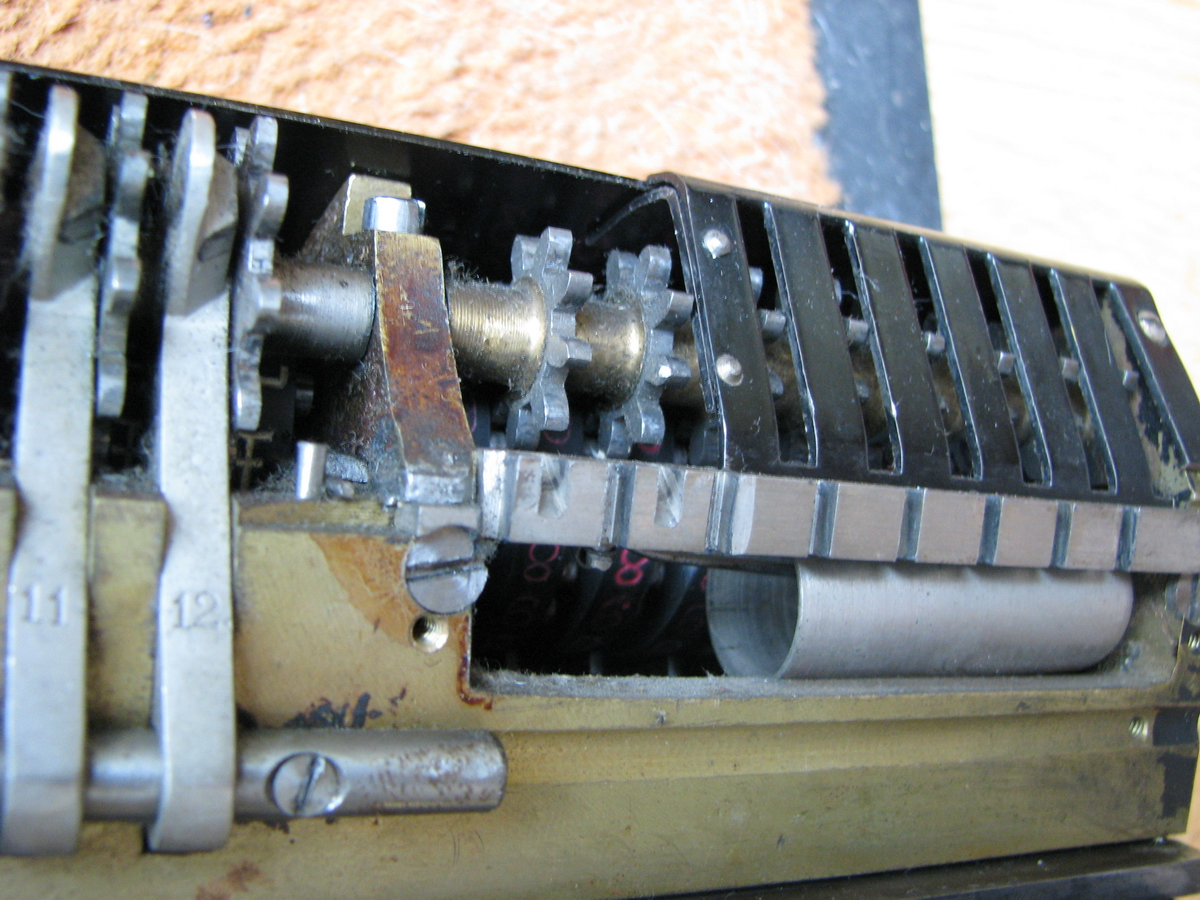
Visually, the most striking difference is the tabulator mechanism, which in the Optimus machine is complicated, but also functional, beautiful and rather unique.
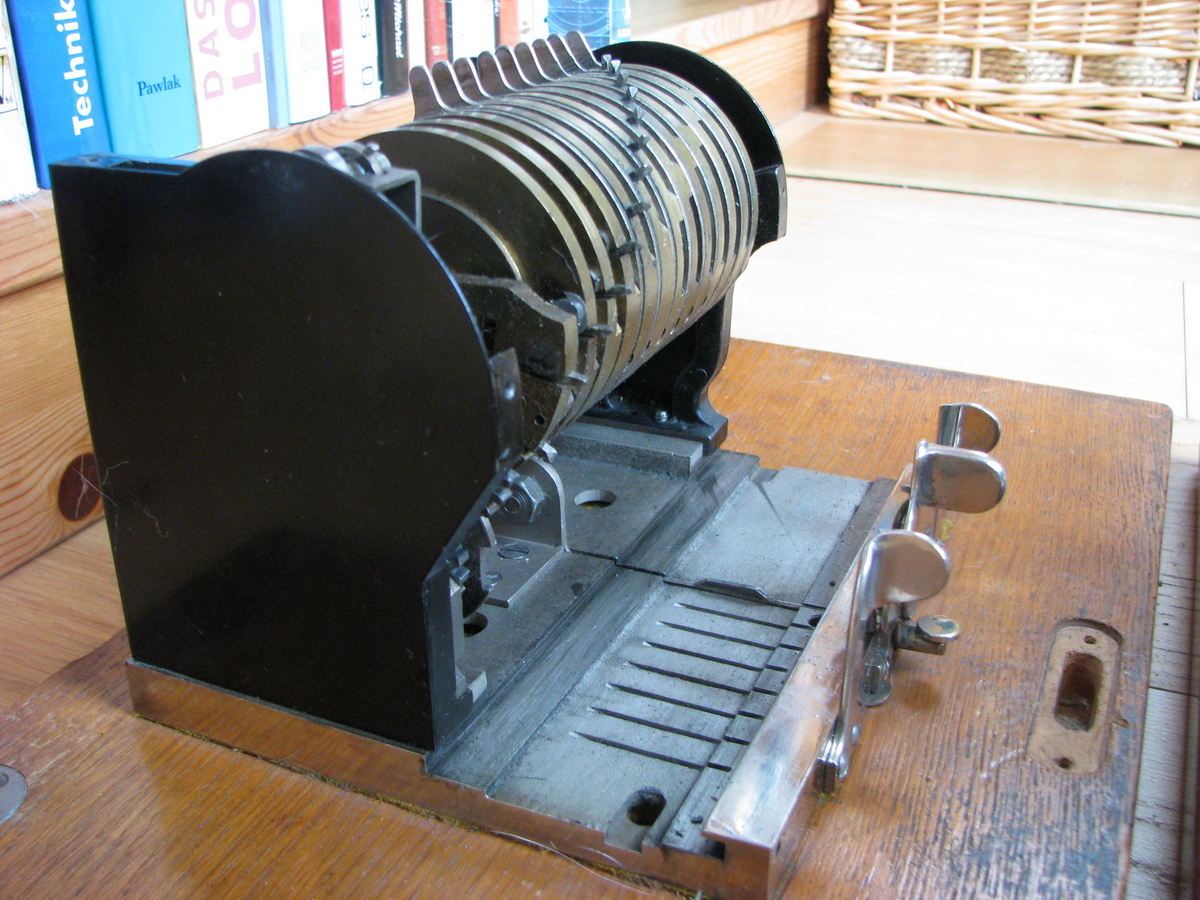

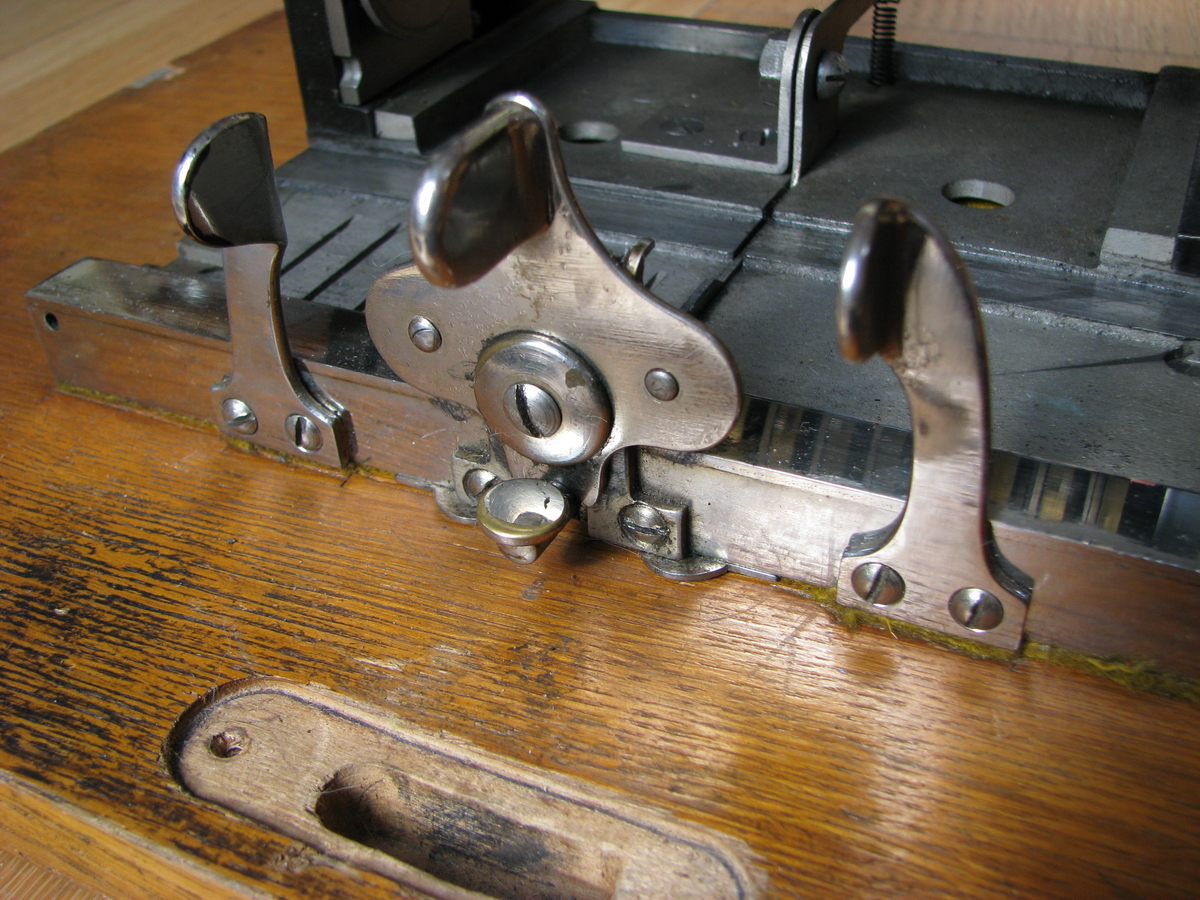

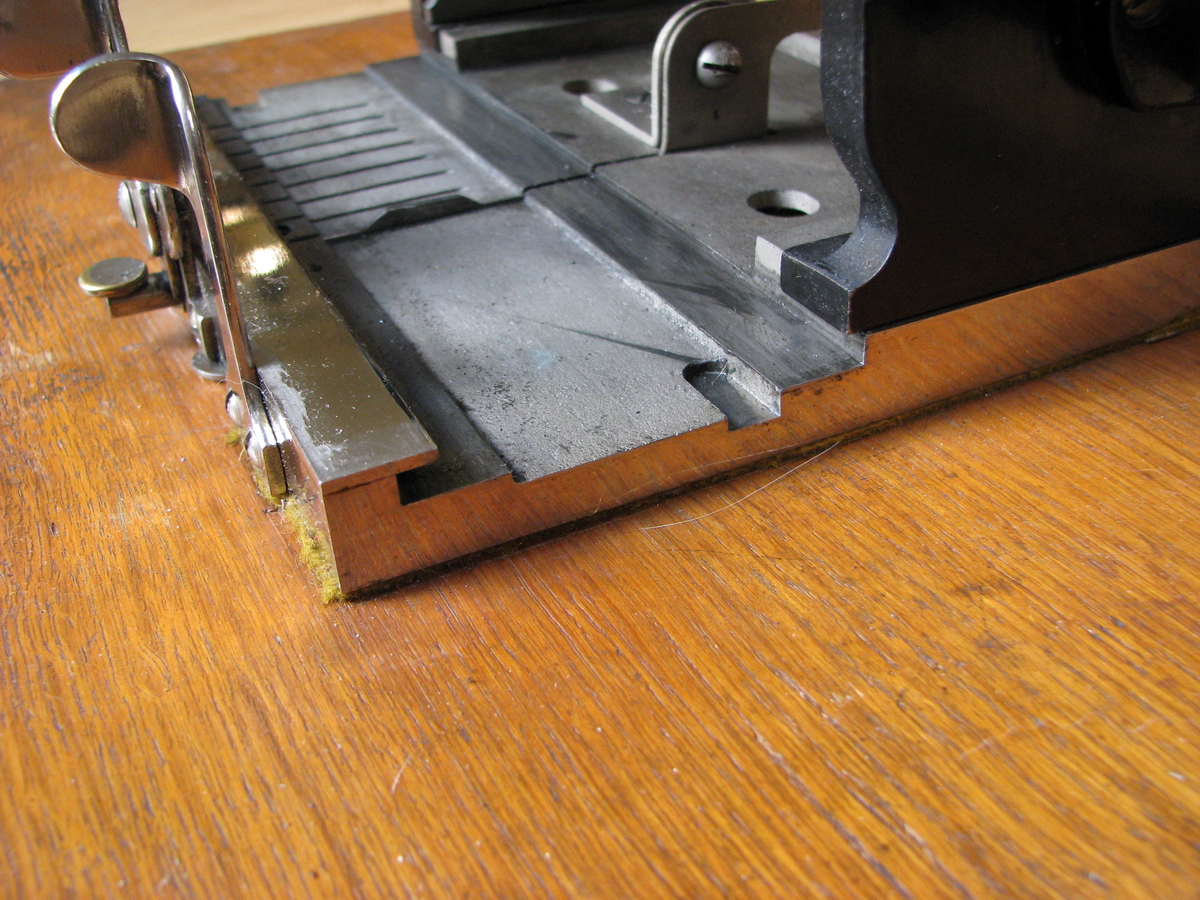
Importantly, it consists of nickeled steel plate, all of which could be cut or stamped and bent into shape in house at Optimus, as opposed to needing machining, thus decreasing the number of parts needing subcontracting. It is based on two elegantly shaped fixed fingerholds screwed to the base plate, and one lever that can pivot to the left and right. In doing so, its particular shape at the bottom end depresses the carriage lock, which is built into the base plate as opposed to inside the carriage in early Odhner machines. This is also the reason why the baseplate had to be re-machined (although we can still recognize it as an Odhner part, since the locating slots for the Odhner carriage lock are also still present there – already machined in St. Petersburg ?). The Optimus mechanism contains, at the back side of the pivoting lever, two sprung hooks, which engage with a toothed comb at the front of the carriage, pushing it one place to the left or right, and springing out of the way of the next tooth when making their return to the centre.
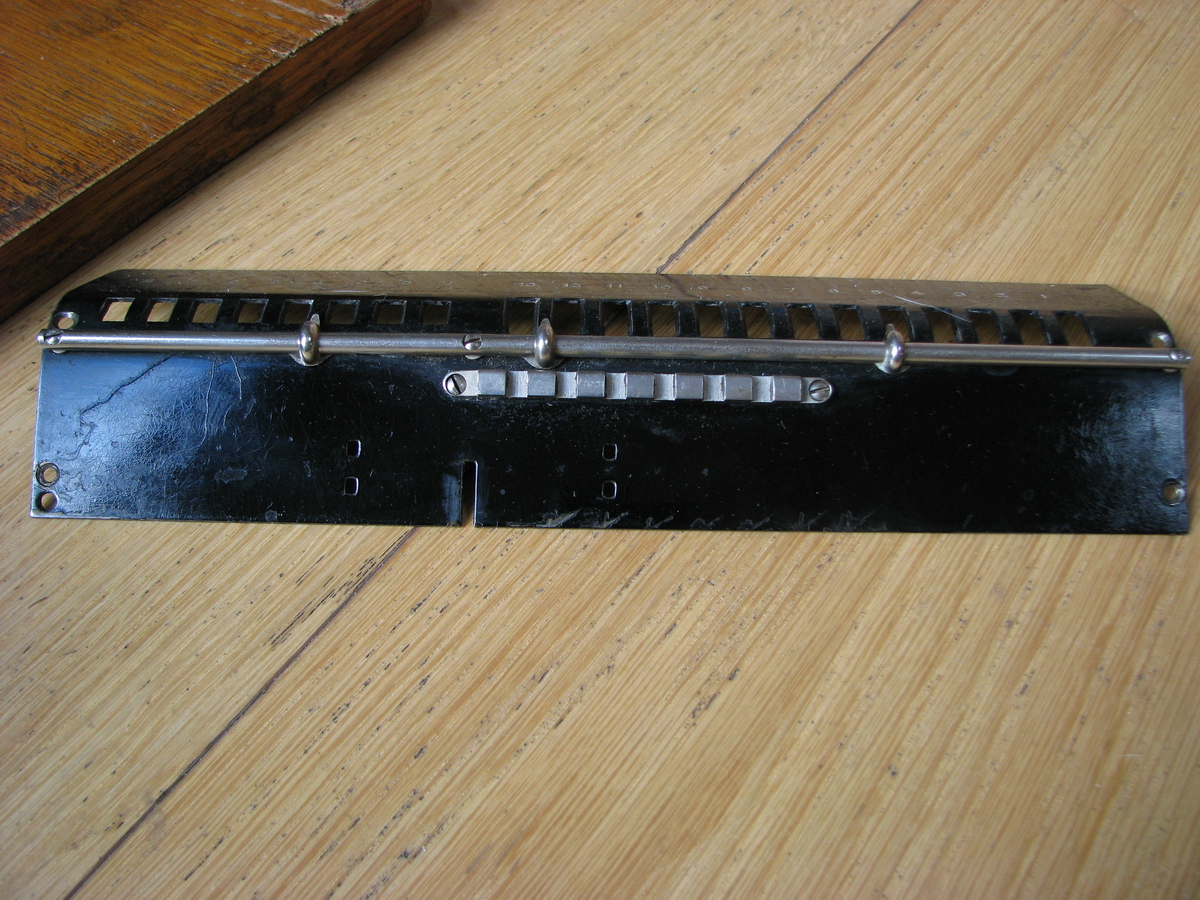
Note, by the way, that the slot for the Odhner carriage lock lever and the holes for riveting the finger tabs are present on the carriage front – again, straight from St. Petersburg ? Round-end slots have been machined in the baseplate to create positive stops for the carriage by screwing a screw into the bottom plate.
All of these modifications have been designed and carried out with a lot of care, clearly by someone who was very much aware of the state of pinwheel calculator technology at the time and the requirements of the market. We have, however, not been able to locate from the patent literature who it could have been.
To date, four machines are known within a range of 366 serial numbers (N° 1184, 1399, 1443, 1550). N° 1399 and 1550 are owned by the authors. If N° 1443 is not the machine in the collection of the Atvidaberg’s Facit museum, then there is most likely a fifth machine there. All in all, a very special, rare, and pretty machine, with a very unique history.
And finally then for some pictures of the machine:
